Dee Estuary Birding
Monthly Newsletter...
July 2023 Newsletter
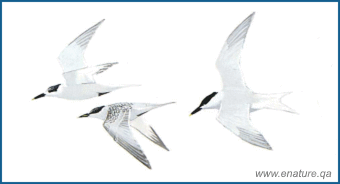
Sandwich Terns and Colour Rings

Unlike Common and Little Terns, there is no Sandwich
Tern breeding colony in the Dee Estuary area, nevertheless it is one of
the most important sites in the country for this species. By the end of
June the first ones arrive with numbers steadily increasing through
early July, and by mid-July the young birds will have arrived.
Hundreds are likely to be present and the one thing you will notice
more than anything else is the sheer noise these bird make - their kirrick calls
seemingly everywhere along the coast.
Sandwich Terns use the Dee Estuary as a staging area
after breeding before heading south for the winter - they will be here
all July and August but by September numbers decrease rapidly. The main
concentrations are at Gronant, Hilbre and the adjacent East Hoyle Bank,
West Kirby and Hoylake. Up until around 10 years ago we could only
guess where these birds had bred as information gleaned from ringing
returns was sparse, to say the least. But colour ringing has made a
dramatic change to our knowledge and we now know a lot about where the
birds come from, and where they go when they leave us, including some
fascinating movements of individual birds.
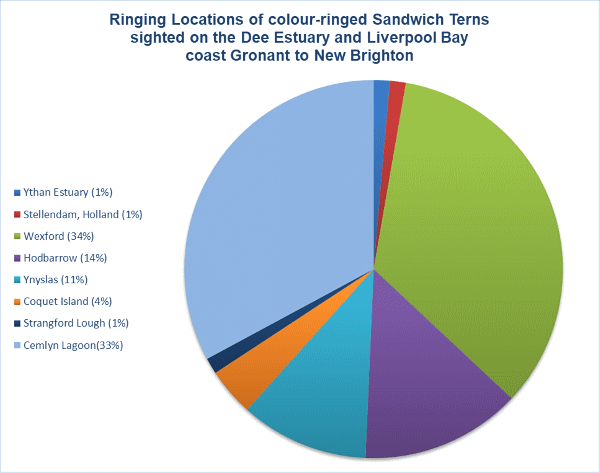
Up until the end of 2022 we have had 91 records of
73
colour-ringed Sandwich Terns on the Dee Estuary and adjacent coast. The
pie-chart
shows where these birds were ringed with the percentage from each site,
and these sites are shown in the map below.
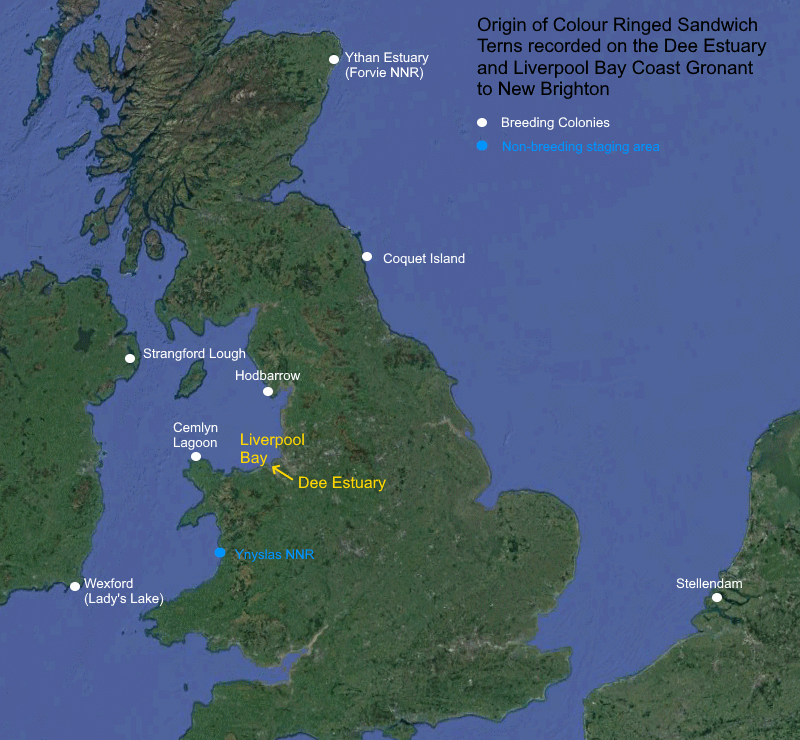
Juveniles Heading north-west from Lady's Lake
As you would expect, a lot of the Sandwich Terns which visit the Dee Estuary and nearby coast come from our two nearest breeding colonies at Hodbarrow in Cumbria and Cemlyn in Anglesey, both around 55 miles away. But, somewhat unexpectedly, we get more recoveries from the Lady's Island Lake Colony at Wexford which is a further 100 miles away and well to the south. At Lady's Island Lake, Tony Murray and colleagues noted that the juveniles left the colony as soon as they fledged (with accompanying parents) such that by late July Sandwich Terns are quite scarce in the area and they where curious about where they went. In 2015 they started a colour ring scheme and by 2019 they had ringed over 1,000 chicks. 208 of these colour ringed juveniles were subsequently recorded (as juveniles) elsewhere and a remarkable 130 were found to have moved north into the Irish Sea (63%) with the majority being seen along the Liverpool Bay coast. We have 35 records from this scheme here on the Dee Estuary and adjacent coast, both as juveniles and subsequently as adults.
Moving around Liverpool Bay
Whichever colony these birds come from they obviously find the coast along Liverpool Bay to their liking and there are likely to be as many as 5,000 present between mid-July and mid-August mainly between the Little Orme in the west, east along the North Wales coast, past the Dee Estuary and north Wirral coast then along the coast at Formby and Ainsdale. Observations of their colour rings show these birds are constantly moving around this area and here are a couple of examples from last summer (2022):
Orange Flag CPH,
ringed at Cemlyn Lagoon on June 26th.
July 13th River Clwyd, Rhyl
August 2nd River Clwyd, Rhyl
August 15th Formby Beach
August 16th River Clwyd, Rhyl
August 20th Hilbre
Green Ring K8K,
ringed at Wexford in 2017.
July 21st River Clwyd, Rhyl
July 23rd Gronant beach
August 1st, 4th and 16th River Clwyd, Rhyl
August 21st Hilbre

The Wrong Way!
One of the most surprising things found by
colour-ringing is that some juveniles not only go much further north
than Liverpool Bay but cross the country the 'wrong way' in order to do
so. Tony Murray mentions (Ref 2) that in 2019 a juvenile from Lady's
Lake was at Tywyn (Cardigan Bay) on 5th August and next spotted at Port
Seton (on the south coast of the Firth of Forth about 10 miles east of
Edinburgh) on September 12th.
That same year a juvenile ringed in Cemlyn Lagoon was also recorded at
Port Seton on three dates - July 27th, August 21st and September 4th.
Then last year,
2022, two more Cemlyn Lagoon ringed juveniles were at Port Seton in
August. These juveniles, with their parents, will have crossed the
country from the Irish Sea to the North Sea which must be quite a
daunting flight for such young birds, and going in the opposite
direction from where they would be traveling in a few weeks time! I
wonder if they then ended up flying back across the country in the
reverse direction or flew down the east coast and through the English
Channel?
Two Interesting Journeys
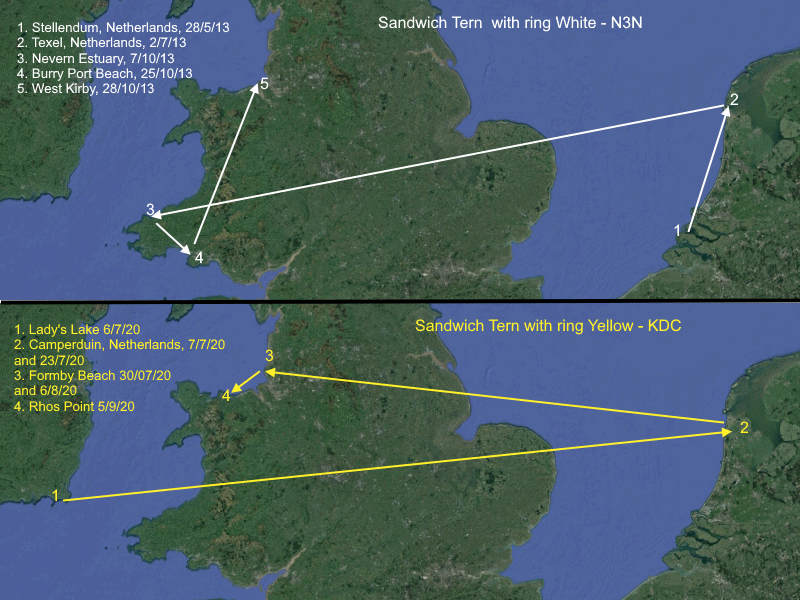
Whilst looking through the Sandwich Tern data in preparation for this article I saw some fascinating movements of these birds, including juveniles flying north-east across the country as related above and the long migration to South Africa when they leave us (see below), but these two journeys by W-N3N and Y-KDC struck me as particularly interesting.
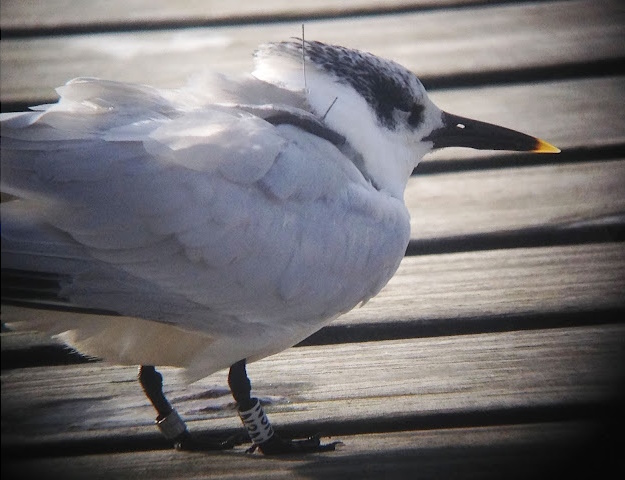
W-N3N was the second colour ringed Sandwich Tern
ever recorded on the Dee Estuary, and it not only had a colour ring but
a GPS tracker - the first one we'd seen of those. It was observed right
at the end of October 2013, a late date for this species with most of
them already off the African coast by then. It had always been assumed
that these late records were of birds heading south from colonies much
further north, but we were wrong about this one! W-N3N was ringed as a
breeding adult near Stellendum (south of Rotterdam), Netherlands, on
28th May 2013. As can be seen in the photo above it was fitted with a
GPS tracker as part of the research into their foraging trips into the
North Sea from the breeding colonies (see Ref 3). It's movement north
to the island of Texel in early July will have been part of the usual
post-breeding dispersal. It then disappeared for three months so we
have no idea whether it stayed in the North Sea or crossed the UK into
the Irish Sea, but we do know it was next spotted on the Pembrokeshire
coast on the Nevern Estuary on October 7th, so already late leaving. It
must have liked it in South Wales as it was still in the area, at Burry
Port Beach, on the 25th. At this date you would have thought it would
be
quickly flying off south, but instead it flew 200 miles north around
the Welsh coast where it was spotted by Colin Jones on a jetty at West
Kirby Marine Lake!
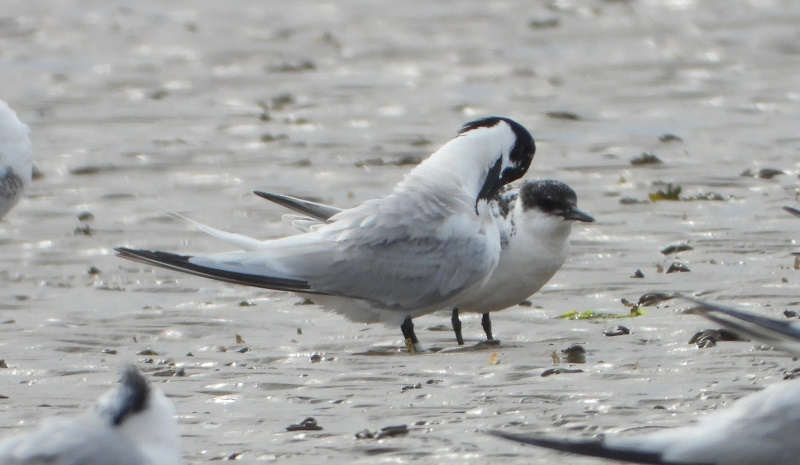
Y-KDC is the most recorded Sandwich Tern in our Dee
Estuary database having been sighted 21 times since being ringed as a
chick in June 2017 at Wexford. It is recorded regularly in the summer
in
the Liverpool Bay area including at Hilbre last July and August. When I
got the history from Tony Murray last year I saw that it had visited
the Netherlands a couple of years ago, my next thought was "that can't
be right".
I saw that in 2020 it was at Lady's Island Lake on July 6th and the
very next day, July 7th, it was at Camperduin on the Netherlands coast!
It was seen there twice and there was no doubt about the ID, but after
doing a few calculations I was surprised to see that for a strong flyer
like a Sandwich Tern it was easily possible to fly the 470 miles
between these two sites over that period of time. If it flew non-stop
over Wales and England at 20mph it would fly the straight line distance
of 470 miles
in around 24 hours, but 20mph is a bit slow for a Sandwich Tern so it
would have had time to deviate, perhaps to the Norfolk Coast, for a
fishing trip and a rest. Just a week after it was last
seen at Camperduin (23rd) it was on Formby Beach, after presumably
crossing over the country again, where it remained into August last
being seen at Rhos Point on the North Wales coast on September 5th.
Do All Sandwich Terns go to South Africa?
When I first started seeing colour ringed Sandwich Terns, in 2016 (my first was W-K3B at Hoylake in July 2016, ringed at Wexford), I thought how exciting it would be to see one that had got as far as South Africa. I guessed that my chances were very slim as surely very few made it that far, and the chances of a colour ringed bird being recorded there were even slimmer. But that has turned out not to be the case and of the 29 adult Sandwich Terns we have recorded on the Dee Estuary in the past three years 10 have been seen either in Namibia or South Africa, a total of 20 times. Considering by no means all the colour ringed birds making it that far south will have been recorded, that seems a very high number and strongly suggests that the majority of Sandwich Terns make the flight to South Africa. A.J. Tree (Ref 4) reckoned that there are typically just under 10% of the East Atlantic Flyway population in South Africa at any one time but that there is continuous movements of birds indicating a high turnover. His analysis of ringing recoveries from Namibia and South Africa showed that just over 50% were ringed in Britain and Ireland, most of the rest being from the Netherlands, Germany and Denmark. So next time you see all those noisy Sandwich Terns on the beach just think that most will be flying all the way to Cape Town, maybe not as far as Arctic Terns travel but still an incredible journey.
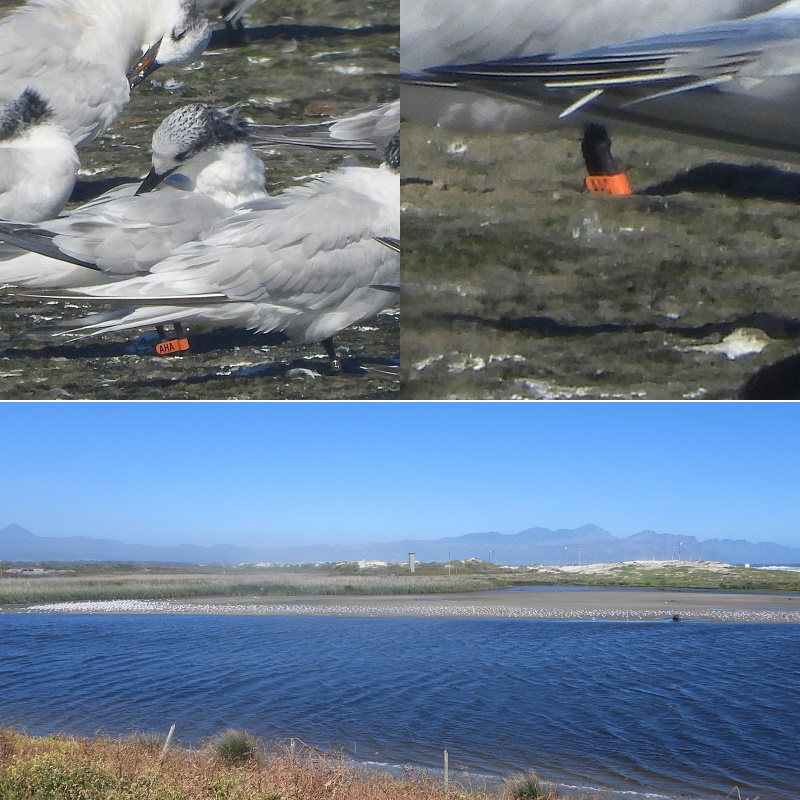
both ringed at Cemlyn Lagoon in 2019 and photographed here at Macassar near Cape Town.
Bottom: View of the Sandwich Tern roost at Macassar, just south of Cape Town SA
photos by Theuns Kruger (October 2020)
References.
1. Richard Smith, Sandwich Terns, July
2020 Newsletter Dee Estuary Birding.2. Tony Murray, Alyn Walsh & David Daly, Post-fledging dispersal of juvenile Sandwich Terns from Lady’s Island Lake, County Wexford, Ireland, Ringing & Migration, 2020 Vol. 35:1.
3. Ruben Fijn et al., Foraging ecology of Sandwich Terns studied via GPS-loggers and colony observations, 2014. Click here to download PDF File.
4. A.J. Tree, Origins, Occurrence and Movements of Sandwich Tern in Southern Africa, Marine Ornithology 39 (2011).
Richard Smith.

O-flag CPU ringed at Cemlyn Lagoon, Y-C66 ringed at Hodbarrow
Colour Ring Report
White-tailed Eagle

Estuary and then west over Wirral and the Dee Estuary and into North Wales.
This map was forwarded to me having originally been sent to Dave Craven who found the bird on the south shore of
the Mersey Estuary (June 21st). I'm assuming it originated from the Roy Dennis Wildlife Foundation, for which many thanks.
Black Ring (G542) and fitted with a GPS transmitter (see above map).
This is a female which was released on the Isle of Wight in 2021
as part of the re-introduction program. She spent last winter in
Norfolk and Suffolk. As the above map shows she flew north past
Stoke-on-trent before heading north-west. We know she landed on
Frodsham Score on the south side of the Mersey Estuary on June 21st as
she was seen
there by Dave Craven. The following day G542 was observed flying off
high and disappeared from view - but not from the GPS satellites which
tracked her crossing Wirral and the Dee Estuary from Caldy to just
south of Mostyn Docks and into North Wales, totally unobserved by local
birders!
To learn more about the White-tailed Eagle
re-introduction project on the Isle of Wight (and other similar
projects) see:
https://www.roydennis.org/isleofwight/
Lesser Black-backed Gull

Yellow (Z2-W)
Ringed on the Ribble Estuary at Banks Marsh in May 2017.
Recorded:
On Hilbre in October 2018 and 2021, August 2022 and 27/05/2023.
Only record away from Hilbre was on the west coast of Brittany in March
2022.
When ringed this bird was fitted with a GPS tag (since fallen off as it was designed to do) as part of a project to investigate the big fall in numbers of this species in Lancashire and Cumbria, and how they are affected by windfarms.
Knots
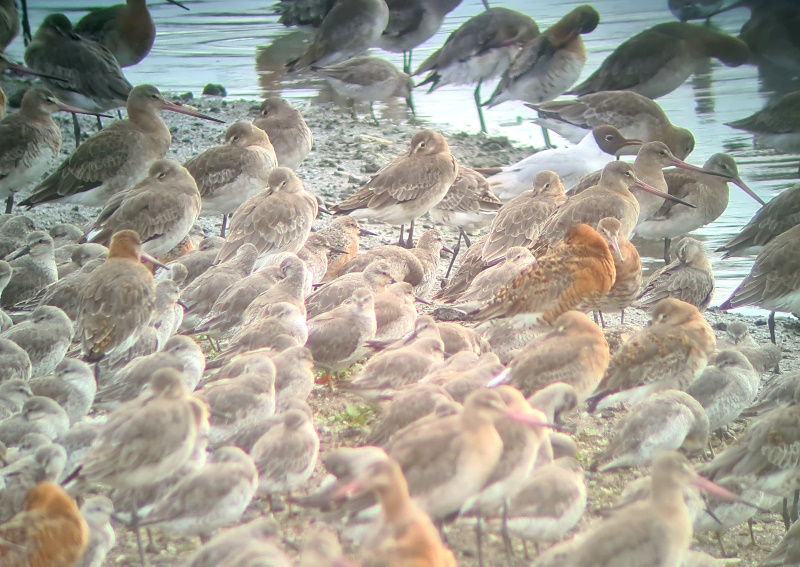
Orange flagged Knot centre
It's very unusual to see over-summering Knots at the Connah's Quay Reserve but this flock shown in the photo visited there on June 25th. Three with Orange flags were spotted as follows:
Oflag (TUA) - Pale
blue ring
Ringed at Ynyslas (Cardigan Bay) on 15/09/2022
Recorded at Thurstaston January 2023.
It was at Formby on April 7th, Oakenholt RSPB on April 8th and back at
Formby on April 19th.
Recorded at Connah's Quay Nature Reserve on 25/06/2023.
Oflag (76M) - Green
Ring
Ringed at Altcar (south Formby Beach) on 21/04/2023.
Recorded at Connah's Quay Nature Reserve on 25/06/2023.
Oflag (09P) - Green
Ring (very faded flag so not 100% sure of code).
Ringed at Altcar (south Formby Beach) on 21/04/2023.
Recorded at Connah's Quay Nature Reserve on 25/06/2023.
Oystercatcher
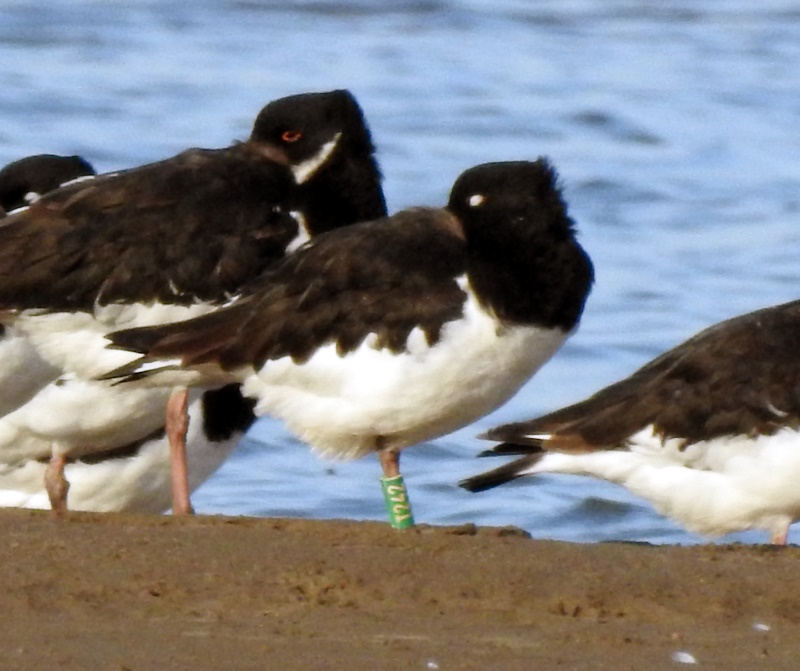
Green (T242)
Ringed in Bergen, Norway, on 17/06/2021, as a chick.
Recorded on Heswall Shore on 29/06/2023.
No other records.
It's usually Aberdeen where various waders are
recorded
breeding on roof tops and in gardens, but this one hatched out at the
Bergen IKEA. We are not sure if it was on the flat roof or somewhere in
the vegetation around the car park!
Colour Rings were recorded by Steve Hinde, Steve Williams, Alex Jones, Colin Schofield and Richard Smith, and thanks to Dave Craven for finding the White-tailed Eagle on Frodsham Score.
Richard Smith
June Bird News
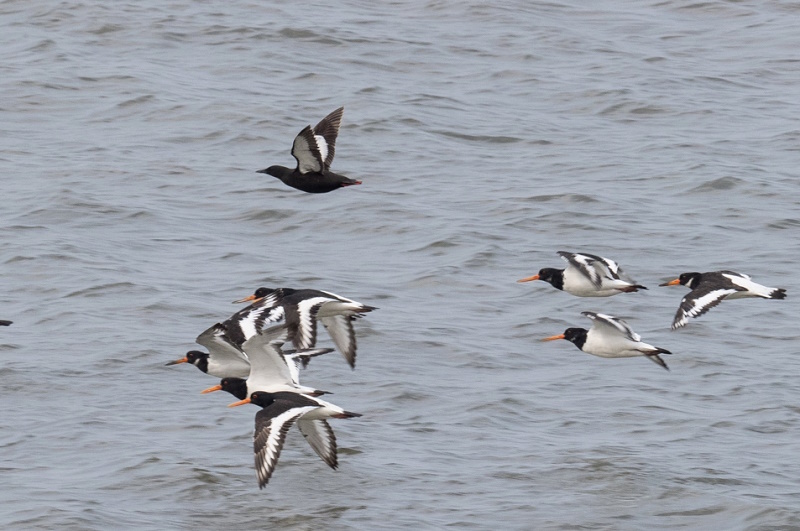
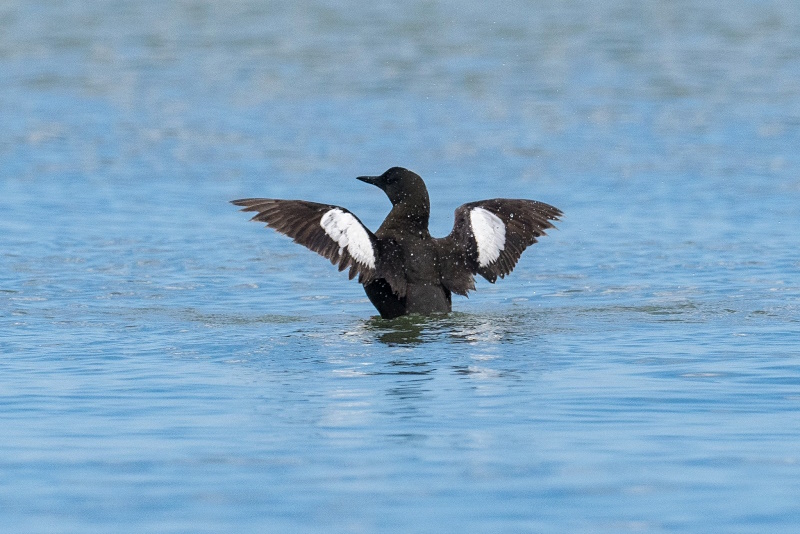
The bird of the month has to be the Black Guillemot that thinks it's an
Oystercatcher! The Black Guillemot, which has been spotted quite a few
times in the past few weeks, usually off Hilbre, took to spending time
on the rocks at the north end of Hilbre this month where it usually
associated with Oystercatchers and, as the photo above shows, often
flying with them. Colin Davies, who visited Hilbre on the 21st, had
this to say in his blog (see more details and photos on https://colinsfieldnotes.blogspot.com/2023/06/black-guillemot-hilbre-island.html):
The bird has for some reason attached itself to the oystercatcher flock and is not shy of asserting itself. When they are on the rocks it roosts with them and flies with them like they are the best of pals, but if it needs to move because of the approaching tide or some other disturbance, it scatters its new friends in all directions by walking towards them, chest puffed out, head held low and flapping it's wings at them to reveal the white under wing and white upper wing patches. It's a bizarre thing to watch. Apparently the last long staying bird, which was around 30 years ago, behaved in a similar way.
It was last seen from Hilbre on the 21st, and it was
presumably the same Black Guillemot which was spotted flying west past
the Point of Ayr on the 28th. Perhaps it has decided to return to it's
more normal habitat around the Great and Little Orme.

A Black-winged Stilt, thought to be a different bird
to the one seen last month, was at Burton Mere Wetlands on the 6th and
7th and gave some great views. Single Curlew Sandpipers, rare here in
June, were at Burton Mere Wetlands on the 3rd and Hilbre on the 15th.
The other big rarity was a White-tailed Eagle flyover on the 22nd. As
detailed in the above 'Colour Ring Report' this was a GPS tagged bird
released on the Isle of wight in 2021, it was seen on the Mersey
estuary on the 21st and flew over the Dee Estuary on the 22nd - sadly
unseen by human eyes but faithfully recorded by the satellite!
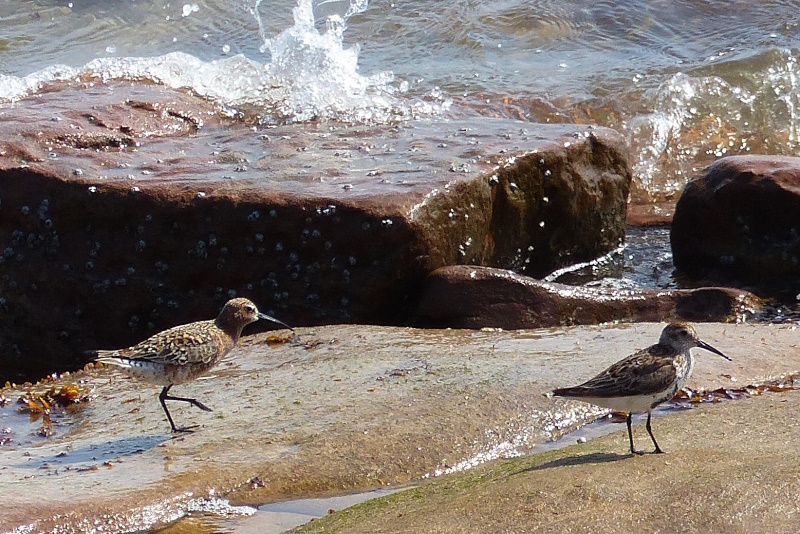
Other waders included at least 50 Sanderlings at
Gronant on the 4th, on their way from Africa to the Arctic. Most
non-breeding Knots which over-summer in the Liverpool Bay area are
found on the Sefton Coast and the Ribble Estuary, with the occasional
brief visit to the outer edges of the Dee Estuary. This year was
different with 400, mostly immature birds, spending most of June at
Burton Mere Wetlands. 150 were also at Connah's Quay Nature Reserve on
the 25th. Two Whimbrels at Heswall on the 17th were also presumably
non-breeding birds.
The first returning waders arrived at Burton Mere
Wetlands on the 16th with a Wood Sandpiper, two Ruff, four Spotted
Redshank and two Little Ringed Plover. 10 Common Sandpipers were along
the River Dee near Connah's Quay on the 25th. Also returning were seven
Mediterranean Gulls at Heswall on the 23rd.
The good weather has meant the Little Terns are
doing well. A record number of nests have been recorded at Gronant and
there is hope, even an expectation, that there will be a big crop of
fledglings.

It's good that after my April Newsletter featuring Stonechats (http://www.deeestuary.co.uk/news0423.htm)
that they are having a good breeding season. I've heard of successful
breeding at Parkgate, Heswall, West Kirby and Leasowe and no doubt
there will be other nests so far unreported.
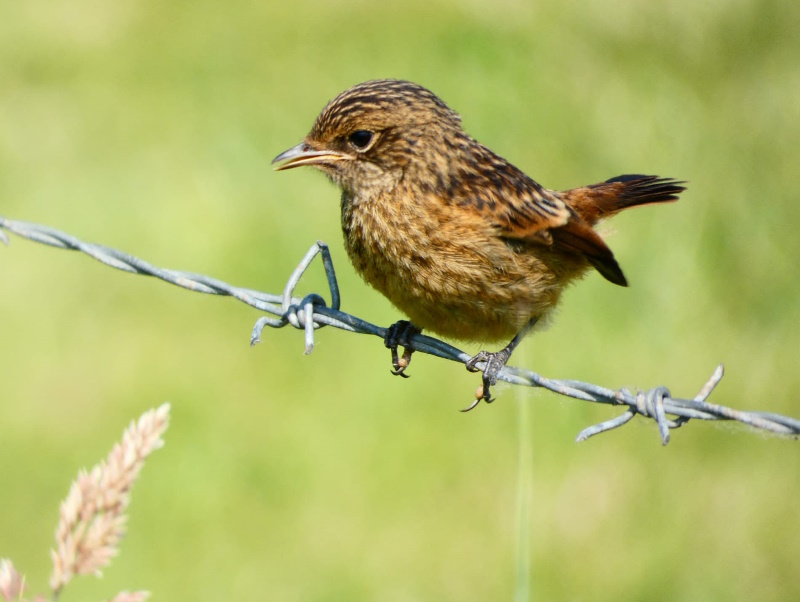
I leave the bad news to the last. Last year the Dee Estuary,
indeed most of the west side of the country, largely escaped the
ravages of Bird flu (HPAI) which was experienced further east. Sadly
the same can't be said this year and we hear that both the Black-headed
Gulls and Common Terns at Shotton Lagoons have been decimated with many
adults dying and no young of either species fledged. I know colonies
elsewhere have also been badly hit. We can but hope they recover over
the coming years.
See https://www.birdguides.com/news/deeside-gull-and-tern-colony-decimated-by-bird-flu/
What to expect in July
There will be a big influx this month as the birds return from breeding. As mentioned in the above article Sandwich Terns are possibly the most noticeable species because of the racket they make! Numbers will increase rapidly so that by the mid-month several hundred will be at Gronant, West Kirby and Hilbre, and the first juveniles will have arrived. There will also be a rapid rise in gull numbers and it's always great to see Mediterranean Gulls still in full breeding plumage - on the 12th last year we had at least 27 spread between Heswall, Thurstaston, West Kirby, Hoylake and Meols - easily double our previous highest count.
One of the most important sites in the country for
moulting Black-tailed Godwits is only a short walk from my house on the
edge of Caldy, the first ones will have returned from Iceland by the
beginning of the month and are likely to reach over 2,500 by the
month-end, by when the first young birds will be arriving. They look
fabulous in their breeding plumage and I'm always a bit sad when they
start moulting into their duller winter feathers.
It was only two years ago when it was realised how attractive the shores of the River Dee are in the Connah's Quay area - between the A494 bridge at Queensferry to the A548 Flint Bridge 35 were counted on July 10th 2021, with 21 there July last year. 35 may not seem a lot except normally it's unusual to see more than one in the same place!
July is often a good month for rarities, 2022 was a bit quiet but in 2021 a Melodious Warbler, Long-billed Dowitcher and Hoopoe were all seen.
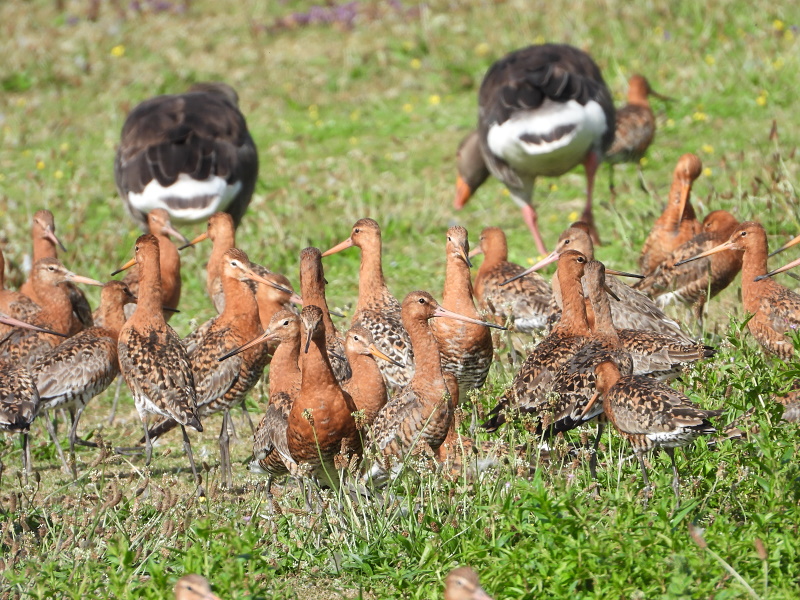
Forthcoming Events
July Highest Spring Tides (Liverpool)
Also see Tides page.
5th July, 12.31hrs (BST), 9.2m.
6th July, 13.21hrs (BST), 9.3m.
7th July, 14.12hrs (BST), 9.2m.
Forthcoming Events
Also see events at https://events.rspb.org.uk/deeestuary